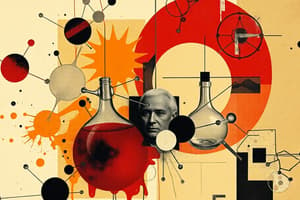Podcast
Questions and Answers
What is a common reason cited for a compound not being aromatic?
What is a common reason cited for a compound not being aromatic?
- Odd number of pairs of electrons
- Presence of planarity
- Disruption of delocalization (correct)
- Lack of conjugation
Which type of compound has an even number of pairs of π electrons in its structure?
Which type of compound has an even number of pairs of π electrons in its structure?
- Antiaromatic compounds (correct)
- Cyclic compounds
- Aromatic compounds
- Aliphatic compounds
What happens to the stability of an aromatic compound compared to a cyclic compound with localized electrons?
What happens to the stability of an aromatic compound compared to a cyclic compound with localized electrons?
- Aromatic compound becomes less stable
- Stability remains the same
- Aromatic compound becomes more stable (correct)
- Depends on the number of carbon atoms in the ring
What is the key characteristic that distinguishes an antiaromatic compound from an aromatic compound?
What is the key characteristic that distinguishes an antiaromatic compound from an aromatic compound?
In which type of compound does delocalization increase stability in 4n+2 systems?
In which type of compound does delocalization increase stability in 4n+2 systems?
'Annulenes' refer to monocyclic hydrocarbons with which specific feature?
'Annulenes' refer to monocyclic hydrocarbons with which specific feature?
For an organic compound to be classified as aromatic, what is a necessary condition related to the value of 'A'?
For an organic compound to be classified as aromatic, what is a necessary condition related to the value of 'A'?
What does it indicate if the 'A' value for a cyclic organic compound is an odd number?
What does it indicate if the 'A' value for a cyclic organic compound is an odd number?
In determining aromaticity, why are localized electron pairs not counted in the evaluation of the 'A' value?
In determining aromaticity, why are localized electron pairs not counted in the evaluation of the 'A' value?
What feature of a compound leads to its classification as non-aromatic, according to the general conditions mentioned?
What feature of a compound leads to its classification as non-aromatic, according to the general conditions mentioned?
How are the values of 'πb' and 'e-p' defined in the context of determining aromatic or anti-aromatic behavior?
How are the values of 'πb' and 'e-p' defined in the context of determining aromatic or anti-aromatic behavior?
If the 'A' value for a cyclic organic compound is 14, how would this compound be classified in terms of aromaticity?
If the 'A' value for a cyclic organic compound is 14, how would this compound be classified in terms of aromaticity?
Which of the following statements is correct about aromatic compounds?
Which of the following statements is correct about aromatic compounds?
The 4n+2 π electron rule for aromaticity was first recognized by:
The 4n+2 π electron rule for aromaticity was first recognized by:
How should the lone pair electrons on heteroatoms like nitrogen or oxygen in aromatic rings be treated when counting π electrons?
How should the lone pair electrons on heteroatoms like nitrogen or oxygen in aromatic rings be treated when counting π electrons?
Which of the following molecules is an example of an anti-aromatic compound?
Which of the following molecules is an example of an anti-aromatic compound?
Which of the following statements about non-aromatic compounds is correct?
Which of the following statements about non-aromatic compounds is correct?
Which of the following molecules has two lone pairs on a heteroatom that may or may not be counted as π electrons?
Which of the following molecules has two lone pairs on a heteroatom that may or may not be counted as π electrons?
Flashcards are hidden until you start studying
Study Notes
Non-Aromatic Compounds
- Lack planarity or have disrupted delocalization
- Can have 4n or 4n+2 π electrons
Anti-Aromatic Compounds
- Planar, cyclic, and conjugated systems with an even number of pairs of electrons
- Meet the first three criteria for aromaticity (planar, cyclic, and conjugated)
- Have an even number of pairs of π electrons (4n, n = 1, 2, 3, etc.)
- Less stable compared to analogous cyclic compounds with localized electrons
Cyclobutadiene and Annulene
- Cyclobutadiene: a monocyclic hydrocarbon with alternating single and double bonds
- Has 4 electrons (even number of pairs; 4n, n = 1)
- Cyclic, planar, and conjugated with an uninterrupted ring of p orbital bearing atoms
- Anti-aromatic and unstable, can only be isolated under controlled conditions
Predicting Aromaticity and Anti-Aromaticity
- Aromatic compounds: value of A = πb + e^-p + 1 (constant) is even
- Anti-aromatic compounds: value of A = πb + e^-p + 1 (constant) is odd
- A = number of π bonds within the ring system + number of electron pairs outside or adjacent to the ring system + 1
General Conditions for Non-Aromatic Behavior
- May lack one or more of the above features (e.g., acyclic, non-planar)
- 'A' value may be even or odd
- Heteroatoms (e.g., N, O, S) and their electron pairs are counted in the evaluation of 'A' value
Studying That Suits You
Use AI to generate personalized quizzes and flashcards to suit your learning preferences.




